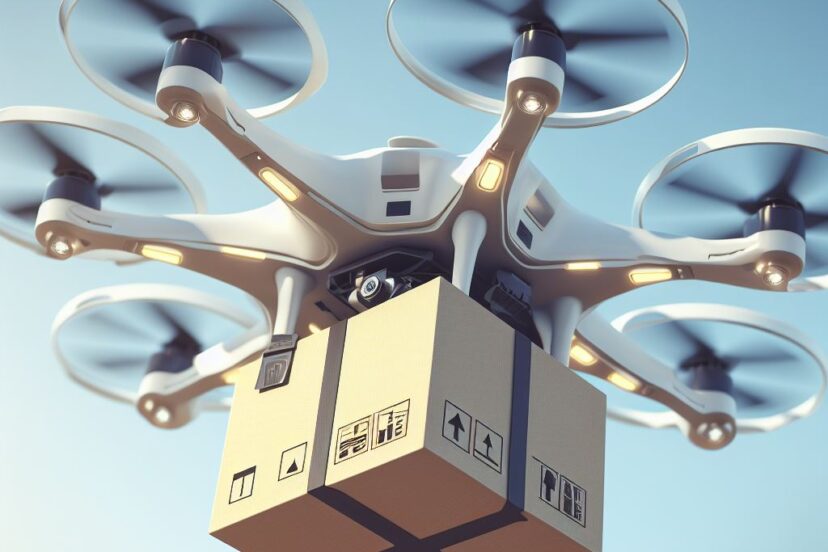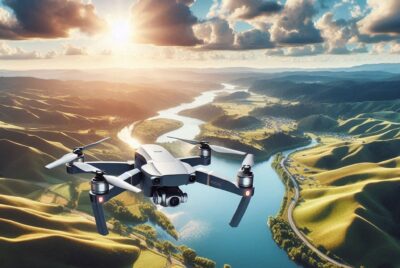Heavy Lift Drone: Revolutionizing Industrial Operations
*We may earn a commission for purchases made using our links. Please see our disclosure to learn more.
Heavy Lift Drone Capabilities: Revolutionizing Industrial Transportation
In the ever-evolving landscape of aerial innovation, heavy lift drones have emerged as a transformative tool for a variety of applications. As someone deeply integrated into the drone technology space, I’ve observed a surge in the demand for these powerful machines across multiple sectors. The heavy lift drone, characterized by it’s capacity to haul substantial payloads, is not just revolutionizing industries; it is redefining the limits of what drones can achieve.

Through my research and hands-on experiences, I’ve learned that heavy lift drones are critical in tasks that range from precision agriculture to urgent firefighting operations. Their ability to carry heavyweight items for extended periods makes them invaluable for applications such as delivery services, geospatial mapping, and even complex cinematography. The versatility of heavy lift drones is unmatched. With continuous advancement, their capabilities are expanding, allowing for the handling of more substantial payloads and enhancing their operational time in the sky.
The commitment to innovation within the drone industry is evident in the design and functionality of heavy lift drones. Manufacturers have honed their craft, presenting models like the DJI Inspire Pro 2 and tailored systems like the Freefly Systems ALTA 6, each offering unique specifications to meet the needs of varied and challenging tasks. These drones are not merely tools but partners in achieving greater efficiencies, enhancing safety, and exploring new frontiers in technology and service delivery.
Design and Technology

In exploring the intricacies of heavy-lift drones, I’ll shed light on their varied designs, the advanced materials that make them up, and the sophisticated motor technologies they employ to achieve their impressive lift capabilities.
Types of Heavy Lift Drones
When it comes to heavy-lift drones, the architecture primarily depends on the number of rotors. The main types are quadcopters, with four rotors, hexacopters, featuring six, and octocopters, which come equipped with eight. The choice between these depends on the payload requirements and redundancy needs; more rotors typically refer to a safer operation due to motor redundancy—you have a backup if one fails.
- Quadcopter: Generally used for smaller payloads but prized for their agility.
- Hexacopter: Strike a balance between lift capacity and maneuverability.
- Octocopter: Preferred for the heaviest payloads, providing maximum lift and motor redundancy for safety.
Materials and Construction
The construction of heavy-lift drones often involves carbon fiber and composite materials, prized for their strength-to-weight ratios. Carbon fiber, for example, allows for a lightweight frame that doesn’t sacrifice durability—essential for lifting heavy payloads. Composite materials further enhance the integrity of drones, ensuring they can withstand the stresses of flight while maintaining a manageable weight.
Materials Used in Heavy-Lift Drones:
- Frame: Most commonly made of carbon fiber due to its lightweight and strength.
- Body and Components: Often a blend of composites for enhanced durability.
Motor and Propeller Technology
The heart of heavy-lift drone design lies within its brushless motors and propellers. Brushless motors are favored for their efficiency and longevity, as they require less maintenance than their brushed counterparts and are better suited to handle the demands of constant heavy lifting. In addition, propeller design is fine-tuned to maximize lift but it is also tailored to the motor configuration to ensure efficient power transfer.
Key Technical Specifications:
- Motors: Typically brushless, to handle heavy loads with efficiency.
- Propellers: Custom-designed to match motor output and maximize lift.
As I walk through the nuanced realm of heavy-lift drones, my focus is on the precision of engineering that goes into every aspect of their design and technology. The synergy between these elements defines the capabilities and reliability of heavy-lift drones in a variety of applications.
Performance and Specifications

In heavy lift drones, precise measurements of payload capacity and flight characteristics define their value. I am focusing on their ability to hoist substantial weights reliably and safely across various flight conditions.
Payload Capacity
Maximum Payload Weight: Heavy lift drones are designed to carry large weights. For example, the DJI Matrice 600 Pro can carry up to 6kg, while specialized drones like the JOUAV PH-20 have a payload capacity of up to 10kg. The maximum takeoff weight includes the drone’s own weight plus the payload.
- DJI Matrice 600 Pro: 6kg payload
- JOUAV PH-20: 10kg payload
Flight Time and Stability
Flight Duration: The time a drone can remain airborne with its payload is crucial. The flight time varies depending on the drone’s design and the weight of the payload. The DJI Matrice 600 Pro offers approximately 38 minutes, while the JOUAV PH-20 excels with up to 70 minutes of flight.
Stability: This refers to the drone’s steadiness during flight, which is vital for accuracy in lifting and maneuvering tasks.
- DJI Matrice 600 Pro: 38 minutes flight time
- JOUAV PH-20: Up to 70 minutes flight time
Lifting Capability
Lifting Mechanism Efficiency: The components, such as propellers, motors, and gimbals, come together to provide a powerful lifting capability. The strength of the drone’s motors in conjunction with the efficiency of the propellers contribute to the drone’s ability to lift and maintain heavy weights during flight.
Payloads such as cameras (Canon 5D, Sony FS700) and other heavy accessories are well within the lifting capabilities of current generation heavy lift drones. However, lifting heavier items requires a drone with high lifting power, like the drones that can hoist over 1,700 lbs as indicated in the search results.
In summary, when assessing the lifting capabilities of heavy lift drones, I consider the harmony between motor strength, propeller design, and the drone’s own weight, ensuring a balance that allows for optimal performance.
Camera and Gimbal Systems

In my experience with heavy lift drones, the importance of robust camera and gimbal systems cannot be overstated for professional video, photography, and capturing high-quality aerial footage.
Gimbal Integration
Gimbals are pivotal for stabilizing heavy lift drones’ payloads, ensuring smooth footage despite external factors like wind or abrupt aircraft movements. My investigations highlight that carbon fiber gimbals, such as the Gremsy Aevo, are often preferred for heavy lift applications. These gimbals combine strength and lightness, and usually come with high-torque brushless motors that provide precise control. Through precision engineering, they maintain a balance between rigidity and compactness, which is essential for high-stakes aerial operations. For instance:
| Gimbal Model | Material | Payload Capacity | Motor Type |
| Gremsy Aevo | Carbon Fiber | High Weight Limit | Brushless |
Integration is key; a correctly mounted gimbal needs to sync seamlessly with the drone’s flight systems to provide real-time stabilization and control.
Camera Drones for Filming
When I discuss camera drones for filming, the focus is often on their ability to carry professional video equipment for aerial shots. Such drones must have the operational capability to handle high-resolution cameras required in filmmaking. The impressive payloads of heavy lift drones like the Gremsy T7, which can carry up to 7 lbs, allow the attachment of various cameras and sensors concurrently. As a result, operators can switch between different types of cameras, whether for live broadcasting or cinematic purposes. The table below illustrates an example payload configuration for professional filming:
| Camera Type | Gimbal Model | Purpose |
| RED Komodo | Gremsy T7 | High-resolution Cinematography |
| Sony α7S | Gremsy T7 | Night Filming |
Overall, the evolution of gimbal technology and the increasing capabilities of camera drones are revolutionizing the way aerial shots are produced, offering unparalleled aerial perspectives in professional filmmaking.
Heavy Lift Drone: Applications and Use Cases

I find that heavy-lift drones have transformed numerous industries through their diverse applications, offering significant advantages in commercial sectors, emergency services, and entertainment.
Commercial and Industrial Use
In the commercial and industrial sectors, heavy-lift drones, often referred to as unmanned aerial vehicles (UAVs), are making a substantial impact. Construction companies use them for inspecting and transporting materials across sites, while the agriculture sector benefits from their ability to monitor crops and distribute fertilizers or seeds. In the energy industry, these UAVs inspect critical infrastructure, such as pipelines and wind turbines, to prevent potential hazards.
- Applications:
- Structural inspections
- Material transportation
- Infrastructure monitoring
- Agricultural monitoring
- Delivery of goods
Search and Rescue Operations
When it comes to search and rescue, the agility and rapid deployment capabilities of heavy-lift drones are invaluable. I’ve learned that these drones assist in locating individuals in vast and inaccessible terrains, delivering supplies such as food, water, or medical kits, and providing aerial views to command centers to enhance situational awareness.
- Applications:
- Victim location
- Supply delivery
- Aerial surveillance
- Disaster assessment
Film and Entertainment Industry
In the realm of film and entertainment, heavy-lift drones have revolutionized movie-making. I’ve noticed their ability to carry high-resolution cameras and other equipment, thereby facilitating breathtaking aerial shots and dynamic perspectives that were previously challenging to capture.
- Applications:
- Aerial cinematography
- Dynamic camera movements
- High-resolution filming
- Virtual reality experiences
Utilizing heavy-lifting drones not only enhances operational efficiency in these domains but also opens up possibilities for innovation across various applications.
Heavy Lift Drone: Regulations and Pilot Training

In advancing through the thresholds of aerial innovation, I am aware that regulations and pilot training are fundamental cornerstones in the domain of heavy lift drone operations. These elements ensure the safe integration of these powerful drones into the airspace and the proficiency of the operators at the controls.
FAA Certification
FAA Requirements: To become an FAA-certified heavy lift drone pilot, I must fulfill specific criteria. This includes holding a type rating for each heavy lift model I intend to fly, mirroring the process for manned aircraft certification. One such type that would require certification is the DJI Matrice 600, a widely recognized heavy lift drone.
- Type Rating: For individual models like the DJI Matrice 600, a unique type rating is necessary, ensuring that pilots are competent with the functionalities and limitations of the drone.
- Regulatory Compliance: Navigating the skies legally mandates that I adhere to the Part 107 regulations, which encompasses the knowledge of airspace classifications, operating requirements, and the legal responsibilities of drone pilots.
Drone Pilot Training Programs
My journey to earning the title of an FAA-certified heavy lift drone pilot is founded on comprehensive training. Renowned programs such as the Drone Pilot Ground School facilitate this education, consistently updated with the latest FAA standards and requirements.
- Curriculum Focus: Training covers a broad spectrum, from operational mastery of a specific heavy lift drone like the DJI Matrice 600 to understanding nuanced weather patterns that affect flight.
- Practical Application: Practical skills are honed through simulations and real-world exercises within the program. Thus enabling me to apply knowledge effectively during operations.
By undertaking the due process of FAA certification and enrolling in recognized drone pilot training programs, I equip myself with the expertise required to excel within the field of heavy lift drone operations.
FAQs About a Heavy Lift Drone
When it comes to heavy lift drones, I often encounter similar inquiries regarding their capabilities, costs, brands, and applications. I’ll address some of the most common questions below to provide clarity.
1. What is the maximum payload capacity of the top heavy lift drones on the market?
The most capable heavy lift drones, such as the Vulcan Airlift, can carry a maximum payload of up to 30kg (approximately 66 pounds). These drones are designed to carry substantial weight for a range of industrial tasks.
2. How much does a high-capacity heavy lift drone typically cost?
The prices of high-capacity heavy lift drones can vary widely depending on specifications. They’re usually part of a professional or industrial equipment category. Costs can range from a few thousand dollars to over $20,000 for advanced models with significant payload capacities.
3. Which brands manufacture the most reliable heavy lift drones?
Brands like Vulcan, JOUAV, DJI, and xFold are known for producing reliable heavy lift drones. These companies have established a reputation in the market for their durable designs and advanced technological integrations.
4. What are the best heavy lift drones available for industrial applications?
For industrial applications, the JOUAV PH-20, JOUAV CW-80E, Vulcan Airlift, and xFold Rigs Travel-8URT are among the best heavy lift drones. They offer substantial payload capacities and are built to meet the demands of various industrial tasks.
5. What should one consider when purchasing a heavy lift drone for commercial use?
When selecting a heavy lift drone for commercial use, one should consider the type of payload, maximum payload capacity, flight time, operational range, ease of use, and after-sales support. It’s important to align the drone’s specifications with the intended commercial operations to ensure efficient and safe usage.




